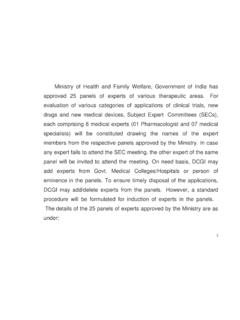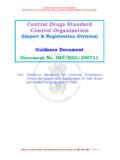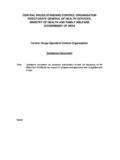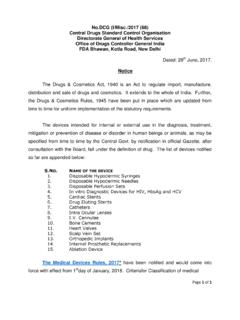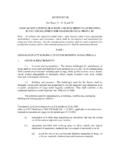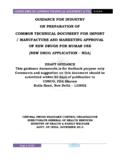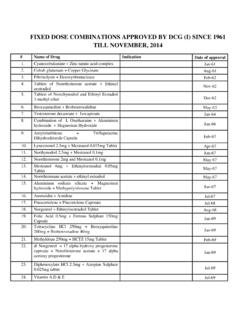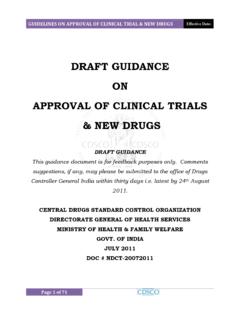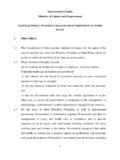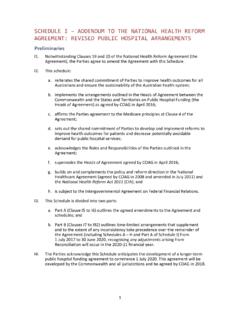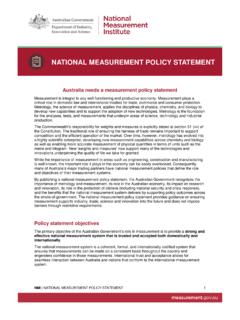Transcription of NATIONAL HEALTH POLICY, 2017
1 NATIONAL HEALTH policy , 2017 Contents 1 Introduction: 1 2 Goal, Principles and Objectives 1 Goal 1 Key policy Principles 1 Objectives 3 Specific Quantitative Goals and Objectives 3 3 policy Thrust 6 Ensuring Adequate Investment 6 Preventive and Promotive HEALTH 6 Organisation of Public HEALTH Care Delivery 7 Primary Care Services & Continuity of Care 8 Secondary Care Services 9 Reorienting Public Hospitals 10 Closing Infrastructure and Human Resource/Skill Gaps 10 Urban HEALTH Care 10 RMNCH+A services 11 Child and Adolescent
2 HEALTH 11 Interventions to address malnutrition and micronutrient deficiencies 11 Universal Immunisation 12 Communicable Diseases 12 Non Communicable Diseases 13 Mental HEALTH 13 Population Stabilisation 13 5 Women s HEALTH and Gender Mainstreaming 14 6 Gender Based Violence 14 7 Supportive supervision 14 8 Emergency Care and Disaster Preparedness 14 9 Mainstreaming the potential of AYUSH 14 10 Tertiary Care Services 15 11 Human Resources for HEALTH 15 12 Financing of HEALTH Care 18 13 Collaboration with Non-Government Sector/Engagement with private sector 19 14 Regulatory Framework 22 15 Vaccine Safety 24 16 Medical Technologies 24 17 Public Procurement 24 18 Availability of Drugs and Medical Devices 24 19 Aligning other policies for medical devices and equipment with public HEALTH goals 24 20 Improving Public Sector Capacity for manufacturing essential drugs and vaccines 24 21 Anti-microbial Resistance 25 22 HEALTH Technology
3 Assessment 25 23 Digital HEALTH Technology Eco - System 25 24 HEALTH Surveys 25 25 HEALTH Research 26 26 Governance 27 27 Legal Framework for HEALTH Care and HEALTH Pathway 27 28 Implementation Framework and Way forward 28 1 1. Introduction The NATIONAL HEALTH policy of 1983 and the NATIONAL HEALTH policy of 2002 have served well in guiding the approach for the HEALTH sector in the Five-Year Plans. Now 14 years after the last HEALTH policy , the context has changed in four major ways. First, the HEALTH priorities are changing.
4 Although maternal and child mortality have rapidly declined, there is growing burden on account of non-communicable diseases and some infectious diseases. The second important change is the emergence of a robust HEALTH care industry estimated to be growing at double digit. The third change is the growing incidences of catastrophic expenditure due to HEALTH care costs, which are presently estimated to be one of the major contributors to poverty. Fourth, a rising economic growth enables enhanced fiscal capacity.
5 Therefore, a new HEALTH policy responsive to these contextual changes is required. The primary aim of the NATIONAL HEALTH policy , 2017, is to inform, clarify, strengthen and prioritize the role of the Government in shaping HEALTH systems in all its dimensions- investments in HEALTH , organization of healthcare services, prevention of diseases and promotion of good HEALTH through cross sectoral actions, access to technologies, developing human resources, encouraging medical pluralism, building knowledge base.
6 Developing better financial protection strategies, strengthening regulation and HEALTH assurance. NHP 2017 builds on the progress made since the last NHP 2002. The developments have been captured in the document Backdrop to NATIONAL HEALTH policy 2017- Situation Analyses , Ministry of HEALTH & Family Welfare, Government of India. 2. Goal, Principles and Objectives Goal The policy envisages as its goal the attainment of the highest possible level of HEALTH and well-being for all at all ages, through a preventive and promotive HEALTH care orientation in all developmental policies, and universal access to good quality HEALTH care services without anyone having to face financial hardship as a consequence.
7 This would be achieved through increasing access, improving quality and lowering the cost of healthcare delivery. The policy recognizes the pivotal importance of Sustainable Development Goals (SDGs). An indicative list of time bound quantitative goals aligned to ongoing NATIONAL efforts as well as the global strategic directions is detailed at the end of this section. Key policy Principles I. Professionalism, Integrity and Ethics: The HEALTH policy commits itself to the highest professional standards, integrity and ethics to be maintained in the entire system of HEALTH care 2 delivery in the country, supported by a credible, transparent and responsible regulatory environment.
8 II. Equity: Reducing inequity would mean affirmative action to reach the poorest. It would mean minimizing disparity on account of gender, poverty, caste, disability, other forms of social exclusion and geographical barriers. It would imply greater investments and financial protection for the poor who suffer the largest burden of disease. III. Affordability: As costs of care increases, affordability, as distinct from equity, requires emphasis. Catastrophic household HEALTH care expenditures defined as HEALTH expenditure exceeding 10% of its total monthly consumption expenditure or 40% of its monthly non-food consumption expenditure, are unacceptable.
9 IV. Universality: Prevention of exclusions on social, economic or on grounds of current HEALTH status. In this backdrop, systems and services are envisaged to be designed to cater to the entire population- including special groups. V. Patient Centered & Quality of Care: Gender sensitive, effective, safe, and convenient healthcare services to be provided with dignity and confidentiality. There is need to evolve and disseminate standards and guidelines for all levels of facilities and a system to ensure that the quality of healthcare is not compromised.
10 VI. Accountability: Financial and performance accountability, transparency in decision making, and elimination of corruption in HEALTH care systems, both in public and private. VII. Inclusive Partnerships: A multistakeholder approach with partnership & participation of all non- HEALTH ministries and communities. This approach would include partnerships with academic institutions, not for profit agencies, and HEALTH care industry as well. VIII. Pluralism: Patients who so choose and when appropriate, would have access to AYUSH care providers based on documented and validated local, home and community based practices.
